Photo

Count Wampyr
Courtesy of The Orkney Library Twitter, if Bram Stoker, author of Dracula, had not come across the name ‘Dracula’ whilst researching at the library, he was going to name his protagonist Count Wampyr.
Wampyr the vampire...
53 notes
·
View notes
Photo
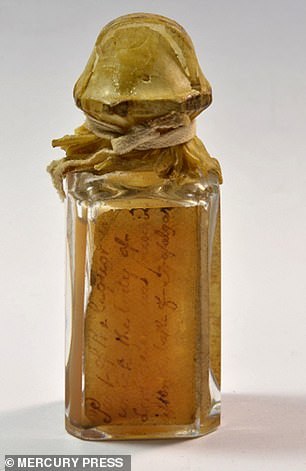
Sucking The Monkey
When Admiral Nelson was killed at the battle of Trafalgar in 1805, his body was preserved in a barrel of rum or brandy so that is could be transported back to England. Well, it was first transported via Gibraltar where it was transferred to a wine-filled lead-lined coffin, but anyway...
Upon the Royal Navy’s triumphant stop-off in Gibraltar, the barrel was allegedly found to be empty of liquids, the contents having been drained through little holes in the base of the barrel with straws, drunk by his fellow sailors. This weirdness coined the term ‘Nelson’s Blood’ as an alternative to rum/brandy and also terms such as ‘sucking the monkey’ and ‘tapping the admiral’ to described the process of drinking rum straight from the barrel with a straw.
The image above is purportedly a small phial of rum or brandy saved from the barrel. Written on the bottle are the words 'Part of the liquor in which the body of Lord Nelson was preserved - after the Battle of Trafalgar.'
I seriously doubt many aspects of this tale and the sources are all over the place but I though it was a fun little Oddment nonetheless.
54 notes
·
View notes
Photo

Martian Canals
“No one would have believed in the last years of the nineteenth century that this world was being watched keenly and closely by intelligences greater than man's and yet as mortal as his own; that as men busied themselves about their various concerns they were scrutinised and studied, perhaps almost as narrowly as a man with a microscope might scrutinise the transient creatures that swarm and multiply in a drop of water.”
― H.G. Wells, The War of the Worlds
This is the story of how an optical illusion and the mis-translation of one word led to the Victorians believing there was life on Mars...
In 1877, Italian astronomer Giovanni Virginio Schiaparelli observed upon the surface of Mars an intricate network of what he called ‘canali.’ A quick Google translate will show that ‘canali’ translates to English as ‘channels,’ which infers something naturally occurring and is precisely what Schiaparelli hoped to describe. He made the above map of said ‘canali.’ For perspective, this is what Mars would have looked like through the type of telescope Schiaparelli would have had access to.
However, people of the 19th century did not have Google translate and someone, somewhere, accidentally translated ‘canali’ to the more phonetically similar ‘canals’ and canals being man-made structures here on Earth, the assumption was made that only sentient beings could have created them on Mars.
Word spread, eventually reaching American astronomer Percival Lowell who was so beguiled by the idea of martian-made canals on Mars, and so convinced of their existence, that he dedicated fifteen years of his life studying them. He wrote extensively of the ‘non-natural features’ and published three books on the subject hypothesising that the canals had been built by a desperate race on a dying planet.
Like Schiaparelli, Lowell mapped the supposed canals:

Though the theory remained popular even throughout the earlier twentieth century, and likely inspired some of the greatest science-fiction writing, the claims of Schiaparelli and Lowell were met with skepticism from many in the astronomical community who swore they could not see anything on Mars’s surface.
As technological advancements allowed for more powerful telescopes the veracity of the claims became increasingly unlikely. The theory was categorically disproved by NASA’s Mariner missions in the 1960s which photographed the surface of Mars and captured no canals. It is most likely that the canals were some strange optical illusion.
22 notes
·
View notes
Photo
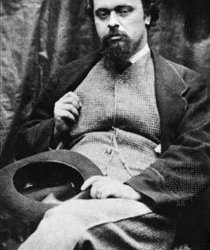
The Buried and Unburied Manuscripts of Dante Gabriel Rosetti.
... Day's appointed sway
Usurped by desolate night. Her pillowed place
Without her? Tears, ah me! For love's good grace,
And cold forgetfulness of night or day.
- From ‘Without Her’ by Dante Gabriel Rosetti.
When poet Dante Gabriel Rosetti’s wife and muse, Lizzie Siddal, died of a laudanum overdose in 1862, Rosetti fell into a deep despair and, feeling he would never be able to write poetry again, buried his final manuscripts with her. A friend described how Rosetti had placed the book beside Siddal’s cheek, curling locks of her famous red curls around it.
Then, seven years later, Rosetti changed his mind.
Blaming himself for Lizzie’s death (he had been a bit of a scoundrel during their marriage) only worsened Rosetti’s emotional state. Concerned, his agent encouraged him to retrieve and publish the buried works as a way reviving both his mental state and his financial situation. Rosetti was convinced.
The exhumation took place in the dead of night on October 5th 1869. The manuscript was retrieved, though it was quite sodden and needed to be taken away for disinfecting; allegedly, there were large worm holes obscuring some of the text and, unsurprisingly, the thing reeked of decay.
Rosetti destroyed the book as soon as he had made copies of his poems, which were published in the volume Poems by D. G. Rossetti in 1870.
Interestingly, Lizzie Siddal was also the model for this famous image of Ophelia. Her Wikipedia is an interesting read in it’s own right and she was buried at Highgate Cemetery in London, in the Rosetti family plot.
15 notes
·
View notes
Photo

Love in the Dolphinarium
Inspired by her favourite childhood book, Miss Kelly, about a cat that can talk to humans, Margaret Howe Lovatt, who had no prior scientific experience, jumped at the chance to be a part of a NASA funded experiment aimed at teaching dolphins human language in preparation for if humankind encountered alien life forms during space exploration.
The three dolphins (Sissy, Pamela, and Peter) were housed in a purpose built dolphinarium where Howe Lovatt would eventually end up living. Her approach to teaching the dolphins human language was to spend as much time as possible with them whilst making human sounds, like a mother might do with a human child. She tried to coax Peter to say “Hello Margaret” and reported that the “m” in particular was difficult for him to do without making bubbles in the water.
After five weeks of Howe Lovatt and Peter spending twenty-four hours a day together, the dolphin began exhibiting sexual urges towards her. Initially when this happened he was taken into a separate pool with the female dolphins so that his needs might be satisfied, but this was a time consuming and logistically difficult task which Howe Lovatt felt interfered with the research they were trying to do.
As a result, "Lovatt took it upon herself to relieve Peter of his urges, rather than going through the long and inconvenient process of transporting him, "It would just become part of what was going on, like an itch, just get rid of that scratch and we would be done and move on.”” Howe Lovatt has always been adamant that the affection was entirely on Peter’s part, not hers, but if that wasn’t the case, she wouldn’t be alone; ‘delphinophiles’ are certainly a real thing and there are numerous examples of people having relationships with dolphins or otherwise finding them attractive.
Ultimately, the project lost it’s funding due to lack of progress and Peter was moved to an unsuitable tank in Miami where the conditions caused him to ‘commit suicide’ by drowning. Howe Lovatt went on to marry a human and have three children.
16 notes
·
View notes
Photo

Diogenes the Cynic
One of Ancient Greek Philosophy’s more controversial figures, Diogenes should be best remembered for his influence on the philosophy of Cynicism and ultimately the school of Stoicism, however, his accomplishments with regards to those is somewhat overshadowed by his rather bizarre, rude, and crude behaviour whilst living on the streets of Athens.
Diogenes was banished from his home in Sinope for debasement of coins and upon arriving in Athens got rid of his belongings and took to a life a vagrancy, sleeping each night inside a large ceramic jar known as a pithos.
Many described Diogenes’s behaviour as dog-like, particularly his eating of food found in the street and his defecating in public. Diogenes himself admired the dog and believed dogs led honest lives free of the artificiality and hypocrisy of human beings. He would share his scraps with the street dogs who would follow him everywhere. The word ‘cynic’ is actually derived from the Greek work ‘kynikos,’ which means ‘dog-like.’
He was also a fierce detractor of Plato and to show this would attend his lectures only to argue with him or cause annoying distractions by loudly eating snacks through them. He would also masturbate in public.
There are anecdotal tales of Alexander the Great meeting Diogenes. The King, apparently quite thrilled at the opportunity, was taken to see the philosopher whilst he sunned himself on top of the pithos in which he lived. Alexander asked Diogenes if there was anything he could do for him, to which Diogenes responded, “Yes, stand out of my sunlight.”
103 notes
·
View notes
Photo

The grave of J. R. R. Tolkien at Wolvercote Cemetery, Oxford.
31 notes
·
View notes
Photo

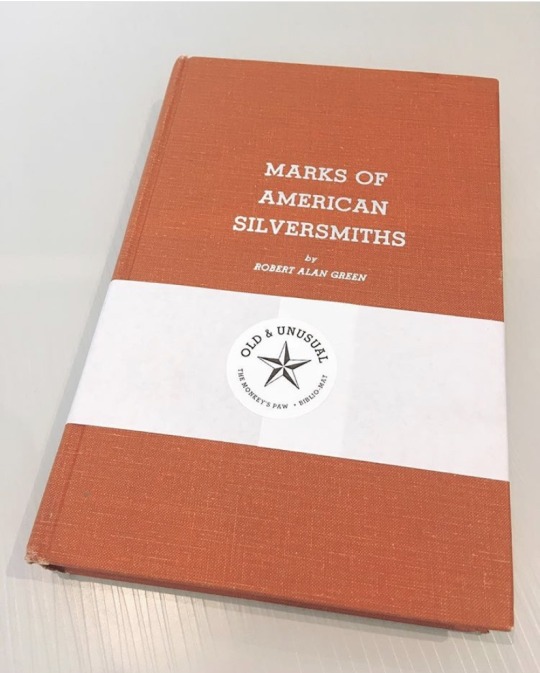
The Biblio-mat at The Monkey’s Paw
I trailed through the boiling hot Toronto streets for an almost an hour to seek out the Biblio-mat, a ‘coin-operated vending machine that dispenses randomly selected old books.’ It was well worth it for this book on Marks of American Silversmiths...
No, the concept is actually really fun and there’s always a thrill in the surprise of an unknown title! Anyone who has ever received a book subscription will know what I’m talking about.
The Monkey’s Paw itself also has a great collection of quirky second hand books.
14 notes
·
View notes
Text
Three Kings on Tour
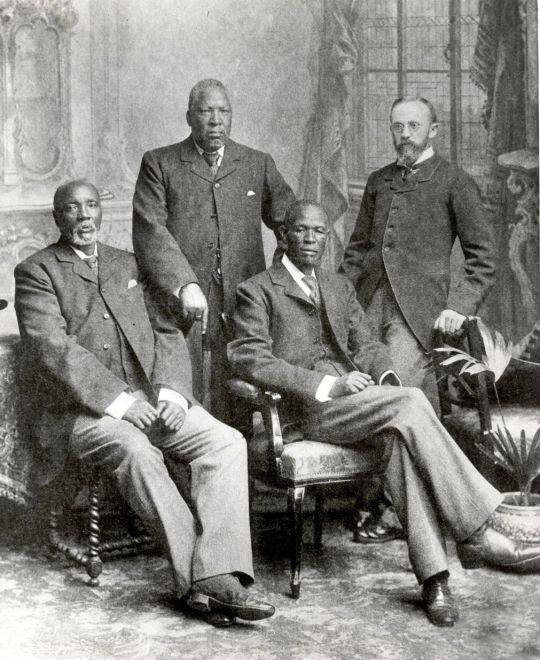
I first heard this story sat beside a campfire, beneath a blanket of stars, listening the calls of lions and hippos in Chobe National Park, Botswana. That introduction sounds made up, but is completely true. We’d had a day of safari and were camping in the bush with nothing but a ring a lanterns between us and the wild. Whilst most of our party had retired to their tents, my friend and I stayed up and chatted with our local guides about the animals, life in Botswana, and the country’s ties to my own, Great Britain.
‘The Empire on which the sun never sets’ was a boast for the vastness of the British Empire between the 18th and 20th centuries but it no longer remains a source of pride and this is something I’ve felt more acutely as I’ve travelled to places that were once colonies and have seen for myself the lasting ramifications. There might be something to be said for the colonialists’ investment in health care, education, infrastructure, spread of democracy etc. but this does not detract from the substantial human cost; dispossession, identity loss, the destruction of cultures, and the massacre of millions.
My history teacher once told me that we spent so much time learning about World War Two in school because they want to make sure our generation doesn’t allow the same thing to happen again. I got the impression it was much the same for our education on colonialism and I think it was against this backdrop that I became fascinated by small acts of rebellion against the great trampling machine of colonialism, such as in the tale of three African chiefs who traveled to England in 1895 to lobby Queen Victorian to protect their land, as told to me by two safari guides over one hundred years later.
In the 1890s the three chiefs, Sebele I, Bathoen I and Khama III, found themselves under increasing threat from the British South African Company, headed by Cecil Rhodes. Rhodes was putting pressure on the British government to annex Botswana to protect the British South African Company’s interests in the area, which would effectively see the leadership of Botswana firmly transferred to the British.
Each diplomatic, responsible, and popular, Sebele, Bathoen, and Khama were fierce protectorates of their land and their people and sought to prevent Rhodes from achieving his ambition. Khama in particular was in general an ally of the British, but after Rhodes used him and his tribesmen to defeat the Amandebele people and then accused him of being a coward for not wiping them out completely, Khama rejected Rhodes and determined to stand in his way.
With support from the London Missionary Society and the Temperance Movement, the chiefs sailed to England to lobby Queen Victoria to help them protect what was rightfully theirs. The safari guides told us that the chiefs sailed to England and presented themselves to the Queen in full tribal dress and although I haven’t seen anything to back that up online, I sincerely hope it is true and can only imagine her majesty’s reaction. Afterwards, Sebele wrote how he “had no idea she was so short and so stout.”
The chiefs spoke up and down the country and were ultimately successful in their mission, particularly with Rhodes’ reputation shattered by the failed Jameson Raid. The Bechuanaland Protectorate was established on the 31st March 1885 and became the Republic of Botswana on 30th September 1966.
A statue of the three chiefs, Three Dikgosi Monument, stands in the Botswanian capital, Gaborone. A statue of Cecil Rhodes which stands at Oxford University, England, is likely to be pulled down in the near future.
#history#africa#colonialism#1800s#19th century#botswana#sebele#bathoen#khama#united kingdom#queen victoria
19 notes
·
View notes
Text
The Illustrated Police News
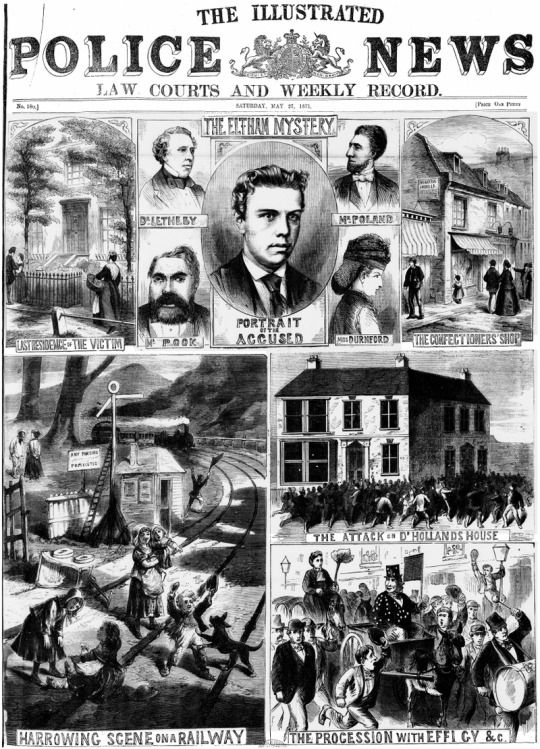
Aligning neatly with the Victorian penchant for curios and the macabre, The Illustrated Police News (1864–1938) was a weekly newspaper providing sensationalised accounts of crimes, disasters, and otherwise miserable events accompanied by cartoonish sketches.
It was the progenitor of the tabloid newspaper and repeatedly emphasised the ‘true’ nature of it’s stories whilst reporting on the most salacious, gruesome, and ridiculous events of the era.
They had a field day with Jack the Ripper, for instance, and also reported on duelling monkeys, shark attacks, and peeping toms amongst other weird and wonderful occurrences.
In 1886 it was voted the worst newspaper in Britain and accused of glorifying crime. Not that that phased the editor, a Mr. George Purkiss, who felt, rather, that it might even encourage people to live good lives so as not to have their picture appear in the paper and anyway, he added, “We can’t all have Timeses and Telegraphs, and if we can’t have the Telegraph or the Times, we must put up with the Police News.”
See more at The British Newspaper Archives.
27 notes
·
View notes
Text
Unsinkable Sam

Sam, the Bismarck’s Cat by Georgina Shaw-Baker (hangs in the UK National Maritime Museum, Greenwich, London).
Unsinkable Sam was a ship’s cat during WWII who survived the sinking of three ships.
His military career started with the Kriegsmarine on board the battleship Bismarck. When Bismarck was sunk by British forces in May 1941, the cat was found floating on debris hours later by sailors on board HMS Cossack. He was named Oscar, or sometimes Oskar with a ‘k’ to honour his German roots.
A few months later, in October 1941, HMS Cossack was sunk by a German torpedo off the coast of Gibraltar. Oscar again survived, earning him the nickname ‘Unsinkable Sam.’ Shortly thereafter he became the ship’s cat on HMS Ark Royal.
In November 1941, HMS Ark Royal was hit by yet another torpedo. Oscar was found amongst very few survivors clinging to a board. He was said to be "angry but quite unharmed."
Deciding that that was quite enough military action for a feline, Oscar was taken to Belfast, Northern Ireland, where he lived out the remainder of his days in a seaman’s home. He died in 1955. There is, of course, the odd naysayer who dismisses Oscar’s adventures as mere sea stories, but personally I think it sounds exactly like something a cat would do.
65 notes
·
View notes
Text
Hannah Twynney kild by a Tygre at ye White Lyon
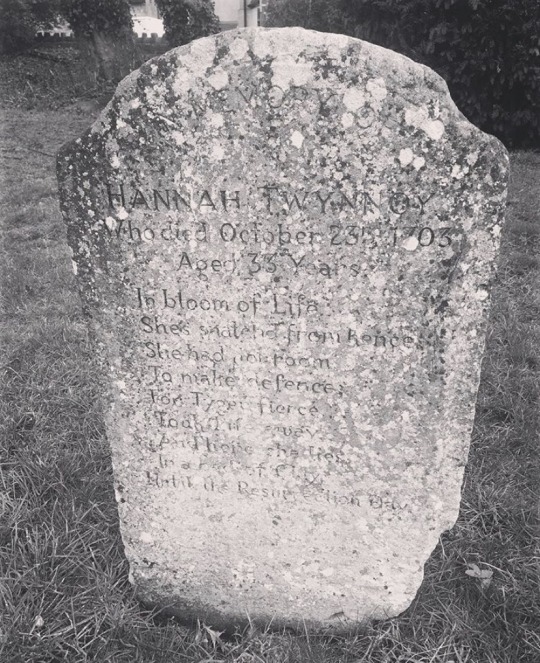
In bloom of Life
She's snatchd from hence,
She had not room
To make defence;
For Tyger fierce
Took Life away.
And here she lies
In a bed of Clay,
Until the Resurrection Day.
- Poem from the grave of Hannah Twynnoy at Malmesbury Abbey.
In the graveyard of an unassuming village in Wiltshire, England, is the grave of Hannah Twynnoy, the first person in Britain to be killed by a tiger. Tigers are not indigenous to Britain, just in case you were wondering, so this is quite curious.
The story goes that Hannah Twynnoy was a barmaid at The White Lion, a pub in the village of Malmesbury. In 1703 a travelling menagerie, ‘an exhibition of wild beasts,’ set up their display in the garden of the pub where Ms. Twynnoy took to harassing the ‘very fierce tiger’ they’d brought along with them ‘not withstanding the repeated remonstrance of its keeper.’
One day the tiger had quite simply had enough of this and it escaped from its enclosure, ‘sprang towards the unhappy girl, caught hold of her gown and tore her to pieces’ (quotes via a local historian).
I visited Hannah Twynnoy’s grave in January 2019 during a little road trip of that part of England (which I would recommend to anyone). All Oddments that I have seen personally are included in the Oddment Odysseys section of the blog, which I obviously also recommend).
47 notes
·
View notes
Text
How to tell the age of a Balaenoptera Musculus.
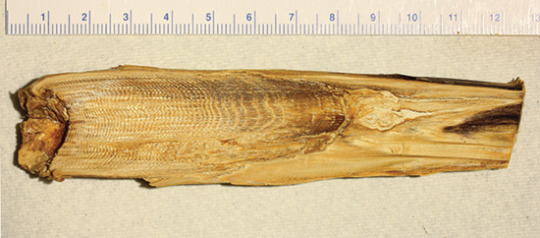
The most reliable way to determine the age of a Blue Whale (and other baleen whales to be precise) is by close examination of their earwax. Throughout their lives they form long plugs of earwax of alternating layers of light and dark shades. The changes in colour are caused by the whales dietary pattern of fasting and feasting and each set is produced over one year, therefore, counting the layers gives an indication of the whale’s age. On average, blue whales live between 80 and 90 years.
Scientists have also studied levels of cortisol, the hormone released in times of stress, found in whales’ earwax to determine the impact of human behaviour on the whales. These studies showed that in the 1920s and 30s, when whale hunting was at it’s peak, more cortisol was found in the whales’ earwax, suggesting that the whales had a profound emotional reaction to the hunting. The ear plugs can also be used to determine the pollutants the whales have been exposed to.
Also interesting is the size of a Blue Whale’s heart.
Photo is from the Smithsonian.
33 notes
·
View notes
Text
Homemaking within the Exclusion Zone
Part Two in the series ‘Unruly: a series on interesting women who did what they wanted.’

Home, whatever one’s feeling about it, is often intertwined with, if not belonging, then our sense of identity. Our experiences of growing up in a low-income area, rural area, multi-cultural area, area of high crime rate or with a good school district, etc. etc. influence who we become, whether naturally or because we choose to rebel against the espoused societal norms. There may be other, more powerful influences, particularly for people who live more nomadic lifestyles, but there is always going to be an intrinsic connection between who we are and where we come from.
So what of those forcibly removed from their ‘home’? There is probably discussion to be had here about the so-called ‘migrant crisis’ in Europe and those who lose their homes in wars, or natural disaster, but my interest is piqued on this occasion by the displacement of thousands of people from their homes near Chernobyl following the nuclear disaster of 1986, and those who chose to return.
When the reactor core at Chernobyl nuclear power plant overheated and exploded in 1986, 400 times more radiation than the bomb dropped on Horishima was spewed into the atmosphere.
This overview by the World Health Organisation outlines some of the numbers of people physically affected by the disaster over the years, but what of the psychological toll, particularly on the internally displaced persons, forced to leave their home behind? Around 116,000 people were evacuated from within the 30km radius of the epicentre of the disaster, including the city of Pripyat and 187 smaller communities. Given the swift nature with which these people had to leave their homes, there was no resettlement plan in place.
Research suggests evidence of the significant psychological consequences for displaced individuals including PTSD, concern regarding future risk of disease, and the negative impact of labelling and stigmatisation as people exposed and damaged by the disaster. Relocated people are more likely to suffer from alcoholism, unemployment, and disrupted social networks.
Few have a better understanding of this than the ’self-settlers,’ more affectionately known as ‘The Babushkas of Chernobyl,’ a group of older individuals, mainly women, who chose to reclaim their ancestral homeland in the months after the disaster. Women who had lived through Stalin enforced famine and Nazi occupation do not fear the invisible threat of radiation; when guards tried to move them out again (it is illegal to live within the 30km exclusion zone), Babushka Hanna Zavorotnya recalls telling them “shoot us and dig the grave - otherwise, we’re staying.”
It is a reasonable assertion that the trauma of relocation would be felt more acutely by the older generations* who would find it more difficult to put down new roots elsewhere and would not have the same opportunities as perhaps the younger evacuees might. The babushkas were allowed back because they were old (and, realistically, were therefore likely to die soon anyway), but many of them have outlived their counterparts who left, about whom it has been said “die of anguish” or “sadness.”
Self-determined and independent the Babushkas pay the price of their exposure to the radiation still emanating from the land, but they have eked existences of relative happiness, avoiding the detrimental impact of the trauma of relocation. As Holly Morris, the director of the documentary ‘The Babushkas of Chernobyl’ has said, “In the end, home trumped radiation.”
*There is also a certain irony in the fact that many people are now making their home on the border of the exclusion zone having fled other parts of Ukraine due to war.
17 notes
·
View notes
Text
Agnès Sorel
Part One in the series ‘Unruly: a series on interesting women who did what they wanted.’

Maîtresse-en-titre was a term not yet coined when a young Agnès Sorel entered the court of Charles VII, though she is considered the first formally recognised mistress of a French king. Beautiful, indeed she was known as La Dame de Beauté, and beguiling, she is alleged to have lured the king out of a deep depression and even to have coaxed him to battle against the English at Normandy.
Naturally, her sway with the King made her unpopular amongst other courtiers and the young dauphin Louis (later Louis XI), who once blamed all the family’s misfortunes on her before punching her in the face, on another occasions pursued her with a dagger, and latterly (possibly) conspired to have her poisoned.
The Queen, conversely, was oddly accepting of Sorel, serving as godmother to Sorel and His Majesty’s three bastard children, despite Sorel upstaging her at any given opportunity. For instance, Sorel had a propensity for elaborate fur-lined clothing, perfumed trains 8 metres long, and hats that stood higher than anyone else, all of which outshone the Queen.
Most scandalous, however, was Sorel’s choice of jewellery. For two centuries the wearing of diamonds by any other than the King had been forbidden by royal decree. But no matter to Agnès Sorel who wore an uncut diamond necklace at court, one which hung in such a way as to accentuate her famously ample bosom, her closeness to the King allowing immunity from punishment for such a flouting of the rules.
Indeed, it is the subject of her bosoms, now that we come to it, which earns Sorel her place in the Emporium: Sorel is commonly believed today to have worn dresses which exposed her left (and favourite) breast. I hasten to add that there are, unfortunately, no contemporary sources for the following claims beyond accusations that Sorel invented “ribald fashions” and that religious leaders petitioned the king to address fashions, popularised by Sorel, with "front openings through which one sees the teats, nipples, and breasts of women." Nonetheless Sorel’s legacy is certainly curious.
In fact, it was likely the painting above, Virgin and Child Surrounded by Angels, a depiction of Sorel as Madonna Lactans, by Jean Fouquet, which started the rumours (alongside this later picture, inspired by Fouquet’s). The real scandal at the time was that an apparently unchaste and wanton woman who engaged in an adulterous relationship with the King, was being portrayed as the Holy Mother.
Sorel died at the age of 28 in 1450, purportedly of dysentery, however, Charles VII was immediately suspicious. Minister Jacques Coeur was imprisoned in relation to the alleged poisoning but fingers were also pointed at Louis who was in open rebellion against his father at the time and had, as above, made his feelings regarding Sorel, abundantly clear.
The theory of a poisoning was so pervasive that in 2005 Sorel’s body was exhumed. It was found to contain excessive levels of mercury, beyond what she would have been exposed to in the use of mercury-laden make-up of the times. It confirmed the likelihood of murder, though the identity of the perpetrator(s) remains a mystery.
An apparently intelligent, charitable, and pious (adultery aside) individual, if Sorel had wanted to walk around with a single breast exposed then I get the impression she would have, but it would be remiss to allow the legacy of a woman who undoubtedly shaped European history, in particular Anglo-French relations through her influence of the King, fashions and cuisine, to be reduced to mere scandal and intrigue.
46 notes
·
View notes
Photo

In 1884, electrical engineer Rookes Crompton wrote, “At the recent Crystal Palace Electrical Exhibition, a couple from the country asked the price of an incandescent lamp at one of the stalls, and being supplied with it for 5s., expended a box of matches in trying to light it, and then declared the whole thing was a swindle.”
1K notes
·
View notes
Photo
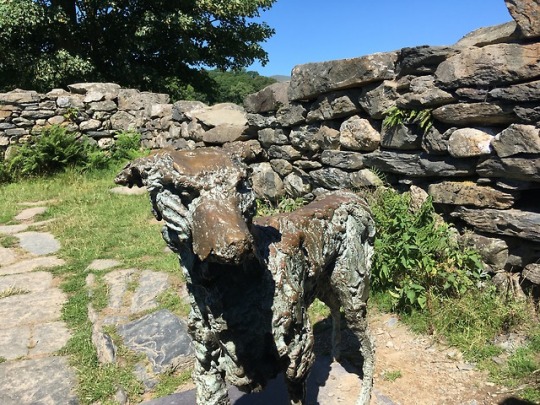

Gelert’s Grave
A short walk from the picturesque village of Beddgelert is the grave of it’s most famous, eponymous resident: Gelert, faithful hound to Prince Llewelyn the Great.
Legend has it that, after a long day of hunting, Prince Llewelyn returned to his palace in the village to find his beloved dog smeared in blood. He rushed to the room of his infant son to find the child missing and, assuming Gelert had killed the boy, plunged his sword into the dog and killed him.
As the dog howled out in pain, a child’s cry responded.
Llewelyn searched the palace and found his son safe and well, the body of a wolf, clearly slain by Gelert as he fought to save the child’s life, by his side. The prince was so distraught by his mistake, he never smiled again.
See Also
Greyfriars Bobby | The Queen’s Corgi Cemetery | Tintagel: King Arthur’s Castle
35 notes
·
View notes